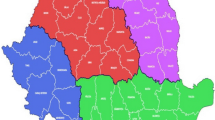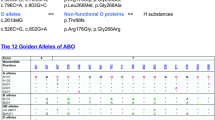Abstract
A key question in biology is whether all cells of a given ‘cell type’ within an individual have more or less the same phenotype, especially in relation to nonimprinted autosomal loci. Some studies have shown differential allelic expression of autosomal genes to confer phenotypic variability at the individual cell level. Here, we report the amount of A and B histo-blood group antigens, products of classic examples of codominant alleles, in individual red blood cells (RBCs). Using immunofluorescence with Cy3-tagged and FITC-tagged antibodies, we quantified the levels of these antigens in 2512 RBCs from 24 individuals in the AB blood group. When these data were fit to a normal distribution, we could detect four groups: showing normal distribution for both antigens, either antigen, and neither antigen. Surprisingly, very few samples showed a significant positive correlation between the amounts of A and B antigens on individual RBC; in fact, the ratio of antigen A to antigen B in the entire set of samples spanned over five orders of magnitude. This variability in the amount of antigens A and/or B, combined with a lack of correlation between the amounts of these two antigens, resulted in unique staining patterns of RBC, generating widespread mosaicism in the RBC population of AB blood group individuals.





Similar content being viewed by others
References
Balea M., Purice S., Chatelain B., Chatelain C., Cornet Y., Dromelet A., Garrino M. et al. 1992 Pattern of antigens A and B distribution on the surface of AB group red blood cells–an argument in support of the concept of “genetic oscillation.” Rom. J. Intern. Med. 30, 269–279 .
Bernhardt I., Nguyen D. B., Wesseling M. C. and Kaestner L. 2020 Intracellular Ca2+ concentration and phosphatidylserine exposure in healthy human erythrocytes in dependence on in vivo cell age. Front. Physiol. 10, 1629.
Bianco-Miotto T., Hussey D. J., Day T. K., O’Keefe D. S. and Dobrovic A. 2009 DNA methylation of the ABO promoter underlies loss of ABO allelic expression in a significant proportion of leukemic patients. PLoS One 4, e4788.
Bódi Z., Farkas Z., Nevozhay D., Kalapis D., Lázár V., Csörgő B. et al. 2017 Phenotypic heterogeneity promotes adaptive evolution. PLoS Biol. 15, e2000644.
Bogdanova A., Kaestner L., Simionato G., Wickrema A. and Makhro A. 2020 Heterogeneity of Red Blood Cells: Causes and Consequences. Front. Physiol. 11, 392.
Chess A. 2016 Monoallelic Gene Expression in Mammals. Annu. Rev. Genet. 50, 317–327.
Cid E., Yamamoto M. and Yamamoto F. 2017 Non-AUG start codons responsible for ABO weak blood group alleles on initiation mutant backgrounds. Sci. Rep. 7, 1–12.
Clausen H. and Hakomori S.-I. 1989 ABH and Related Histo-Blood Group Antigens; Immunochemical Differences in Carrier Isotypes and Their Distribution. Vox Sanguinis 56, 1–20.
Cooling L. 2015 Blood groups in infection and host susceptibility. Clini. Microbiol. Rev. 28, 801–870.
Crowley J. J., Zhabotynsky V., Sun W., Huang S., Pakatci I. K., Kim Y. et al. 2015 Analyses of allele-specific gene expression in highly divergent mouse crosses identifies pervasive allelic imbalance. Nat. Genet. 47, 353–360.
Dabelsteen E. and Mackenzie I. 1976 Selective loss of blood group antigens during wound healing. Acta Pathol. Microbiol. Scand. Sec. A Pathol. 84, 445–450.
Darrow M. C., Zhang Y., Cinquin B. P., Smith E., A, Boudreau R., Rochat R. H. et al. 2016 Visualizing red blood cell sickling and the effects of inhibition of sphingosine kinase 1 using soft X-ray tomography. J. Cell Sci. 129, 3511–3517.
Deng Q., Ramskold D., Reinius B. and Sandberg R. 2014 Single-cell RNA-seq reveals dynamic, random monoallelic gene expression in mammalian cells. Science 343, 193–196.
Espinosa-Soto C., Martin O. C. and Wagner A. 2011 Phenotypic plasticity can facilitate adaptive evolution in gene regulatory circuits. BMC Evol. Biol. 11, 5.
Gimelbrant A., Hutchinson J. N., Thompson B. R. and Chess A. 2007 Widespread monoallelic expression on human autosomes. Science 318, 1136–1140.
Hata Y., Kominato Y., Yamamoto F.-I. and Takizawa H. 2002 Characterization of the human ABO gene promoter in erythroid cell lineage. Vox Sanguinis 82, 39–46.
Huang H., ** S., Liu X., Wang Z., Lu Q., Fan L. et al. 2019 Molecular genetic analysis of weak ABO subgroups in the Chinese population reveals ten novel ABO subgroup alleles. Blood Transfusion 17, 217–222.
Isa K., Yamamuro Y., Ogasawara K., Yabe R., Ogiyama Y., Ito S. et al. 2016 Presence of nucleotide substitutions in the ABO promoter in individuals with phenotypes A 3 and B 3. Vox Sanguinis 110, 285–287.
Kihm A., Kaestner L., Wagner C. and Quint S. 2018 Classification of red blood cell shapes in flow using outlier tolerant machine learning. PLoS Comput. Biol. 14, e1006278.
Kominato Y., Sano R., Takahashi Y., Hayakawa A. and Ogasawara K. 2020 Human ABO gene transcriptional regulation. Transfusion 60, 860–869.
Liumbruno G. M. and Franchini M. 2013 Beyond immunohaematology: the role of the ABO blood group in human diseases. Blood Transfus. 11, 491–499.
Marsh W. L., Ferrari M., Nichols M. E., Fernandez G. and Cooper K. 1973 BHm a Weak B Antigen Variant. Vox Sang. 25, 341–346.
Moras M., Lefevre S. D. and Ostuni M. A. 2017 From erythroblasts to mature red blood cells: organelle clearance in mammals. Front. Physiol. 8, 1076.
Neel J. V. 1949 The inheritance of sickle cell anemia. Science 110, 64–66.
Quint S., Christ A. F., Guckenberger A., Himbert S., Kaestner L., Gekle S. et al. 2017 3D tomography of cells in micro-channels. Appl. Phys. Lett. 111, 103701.
Reinius B. and Sandberg R. 2015 Random monoallelic expression of autosomal genes: stochastic transcription and allele-level regulation. Nat. Rev. Genet. 16, 653–664.
Reinius B., Mold J. E., Ramsköld D., Deng Q., Johnsson P., Michaëlsson J. et al. 2016 Analysis of allelic expression patterns in clonal somatic cells by single-cell RNA–seq. Nat. Genet. 48, 1430–1435.
Sadafi A., Koehler N., Makhro A., Bogdanova A., Navab N., Marr C. et al. 2019 Multiclass deep active learning for detecting red blood cell subtypes in brightfield microscopy. In International Conference on Medical Image Computing and Computer-Assisted Intervention 685-693. Springer..
Sano R., Nakajima T., Takahashi K., Kubo R., Kominato Y., Tsukada J. et al. 2012 Expression of ABO blood-group genes is dependent upon an erythroid cell–specific regulatory element that is deleted in persons with the Bm phenotype. Blood 119, 5301–5310.
Sano R., Nakajima T., Takahashi Y., Kubo R., Kobayashi M., Takahashi K. et al. 2016 Epithelial expression of human ABO blood group genes is dependent upon a downstream regulatory element functioning through an epithelial cell-specific transcription factor, Elf5. J. Biol. Chem. 291, 22594–22606.
Seltsam A. and Blasczyk R. 2005 Missense mutations outside the catalytic domain of the ABO glycosyltransferase can cause weak blood group A and B phenotypes. Transfusion 45, 1663–1669.
Seltsam A., Wagner F. F., Grüger D., Gupta C. D., Bade-Doeding C. and Blasczyk R. 2007 Weak blood group B phenotypes may be caused by variations in the CCAAT-binding factor/NF-Y enhancer region of the ABO gene. Transfusion 47, 2330–2335.
Tuppy H. and Staudenbauer W. L. 1966 Microsomal incorporation of N-acetyl-D-galactosamine into blood group substance. Nature 210, 316–317.
Veitia R. A., Caburet S. and Birchler J. A. 2018 Mechanisms of Mendelian dominance. Clin. Genet. 93, 419–428.
Von Dungern E. and Hirschfeld L. 1911 Ueber Vererbung gruppenspezifischer Strukturen des Blutes. Mol. Gen. Genet. 5, 196–197.
Watkins W. M. and Morgan W. T. 1993 Possible genetical pathways for the biosynthesis of blood group mucopolysaccharides. Vox Sang. 64, 245–245.
Witkop C. J. Jr, Nance W. E., Rawls R. F. and White J. G. 1970 Autosomal recessive oculocutaneous albinism in man. Evidence for genetic heterogeneity. Am. J. Hum. Genet. 22, 55–74.
Yamamoto F.-I., Clausen H., White T., Marken J. and Hakomori S.-I. 1990 Molecular genetic basis of the histo-blood group ABO system. Nature 345, 229–233.
Zhu H., Zheng T., Yu J., Zhou L. and Wang L. 2018 LncRNA XIST accelerates cervical cancer progression via upregulating Fus through competitively binding with miR-200a. Biomed. Pharmacother. 105, 789–797.
Zschocke J., Byers P. H. and Wilkie A. O. M. 2022 Gregor Mendel and the concepts of dominance and recessiveness. Nat. Rev. Genet. 23, 387–388.
Acknowledgements
We thank Dr R. Sarkar for help with statistics, Ms. R. Nandini for technical help with microscopy and CSIR for financial assistance to RAJ and AB. This project was supported by intramural funding from CSIR to RAJ.
Author information
Authors and Affiliations
Contributions
RAJ, conceived and designed the experiments; AB, BS & PM, performed the experiments; RAJ, AB and VJ, analyzed the data; RAJ and VJ, wrote the paper.
Corresponding author
Additional information
Corresponding editor: B. K. Thelma
Rights and permissions
About this article
Cite this article
BAJPAI, A., JONNALAGADDA, V., SRIDEVI, B. et al. Single-cell variations in the expression of codominant alleles A and B on RBC of AB blood group individuals. J Genet 101, 36 (2022). https://doi.org/10.1007/s12041-022-01376-9
Received:
Revised:
Accepted:
Published:
DOI: https://doi.org/10.1007/s12041-022-01376-9




